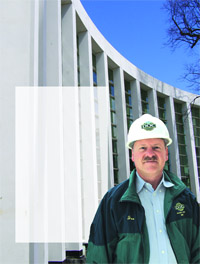Starting at a community college and then transferring to a four-year school has been a common strategy for decades at area schools. But there is evidence that more young people — often with encouragement from parents who will pay all or part of the bill — are taking the transfer route for financial and practical reasons. This trend is being facilitated by joint-admission agreements between the community colleges and both public and private four-year schools that could eventually boost enrollment at those institutions and keep more college graduates in the Pioneer Valley.
Nick Fusini’s career ambitions changed somewhat roughly a year after he enrolled at Springfield Technical Community College; his original plan was to get into civil engineering; however, he later focused his sights on the related field of construction management.
But his game plan for achieving his bachelor’s degree didn’t change.
From the start, his strategy was to start at a community college and then transfer to a four-year school, and the driving force behind that plan was simple: money — perhaps $50,000 by his estimates.
That’s how much the Dalton resident projects he’ll save by spending two years at STCC (annual tuition: roughly $5,000) and then transferring to the Wentworth Institute of Technology in Boston (current tuition: about $30,000), which recently sent him an acceptance letter. Just how much he’ll actually save remains to be seen because he’s not sure if he’ll be at Wentworth for two or three years — there is uncertainty about how many of his credits will be transferable — but he knows the total volume of student loans he’ll be repaying years down the road will be a fraction of what they would have been had he started and finished at the four-year college.
“I knew I could save a lot of money doing it this way,” said Fusini, who took a break from studying for finals to talk with BusinessWest. “I knew I’d be taking mostly the same courses to start here or at a four-year school, so it just made sense to take them here.”
Starting at a community college and then transferring to a four-year school — for reasons ranging from pure economics to general uncertainty over a course of study to both — is hardly a recent phenomenon. But it is happening with greater frequency these days, in large part because of the spiraling cost of a college education, and the fact that many (if not most) students simply don’t know what they want to study when they get to college.
And it makes a great deal of sense to spend $10,000 to try and find out, as opposed to $50,000 or, at the rate things are going, $100,000.
That’s what Mark Broadbent tells those looking at or enrolled within Holyoke Community College, which he serves as coordinator of Transfer Affairs. He told BusinessWest that he has definitely seen a surge in the number of students making both conscious and unconscious decisions to start their secondary education at HCC and finish it somewhere else. Sometimes, the students, both traditional and non-traditional, will make such a decision themselves, but, increasingly, the discussion is being started by parents who are paying all or some of the freight.
“We’re hearing about more parents saying, ‘we’ll pay for your education, but start here first and then figure out where you want to go, because I’m not wasting time and money while you go play around at a four-year school,’” said Broadbent, referring specifically to HCC but implying any community college.
And while young people and their parents are warming to the idea of starting at community colleges and then transferring, several recent initiatives make it easier for them to do so. These include articulation and joint-admission agreements between the community colleges and several area schools, both public and private, and, more recently, a Jack Kent Cooke Foundation grant designed to help elite schools create more economic diversity on their campuses by generating more transfers from community colleges.
Locally, Amherst College and Mount Holyoke College are participating in the program, which also includes Bucknell, Cornell, the University of Southern California, and other schools.
The joint-admission agreements vary somewhat in their language and grade point average requirements, but the tone is the same. Essentially, if someone attending a community college meets certain requirements, they will gain automatic acceptance to a four-year school upon graduation.
And there are some financial incentives for students to do so. Those who go from STCC, HCC, Greenfield Community College, or Berkshire Community College to AIC, for example, and have at least a 2.7 GPA will receive $6,000 in annual tuition assistance as long as they remain a full-time student.
Such incentives are enabling more students to transfer immediately after earning their associate’s degrees, said Pam White, director of Cooperative Education, Career Services, and Transfer Affairs at STCC.
“Before, people were still transferring, but some would put transfer on hold for a year or a semester,” she said, listing reasons ranging from finances to uncertainty over the need for the four-year degree. “But with these joint-admission program for both private schools and the Massachusetts state system, I think we’ll be seeing an increase, because it will be more affordable.”
This issue, BusinessWest examines this emerging trend in education and career development, and what it means for students, their parents, area schools, and even the region’s economy, which many say will stand to benefit if more people obtain four-year degrees — and earn them in the 413 area code.
Course of Action
STCC President Ira Rubenzahl told BusinessWest that many of today’s college students have a different mindset about their education, and how and where it will unfold, than previous generations.
Years ago, students would enter a college with the expectation that they would graduate from it two or four years later, he explained, adding that, generally speaking, today’s young people don’t have that same thought process.
“This generation moves around a lot; sometimes they’ll start at a four-year school, transfer here, and then transfer back or to another four-year school,” he said, adding that reasons for such movements vary from a change in major to dissatisfaction with an institution to that common theme of economics.
The phenomenon helps explain an increase, both locally and nationally, in the number of people taking what many call the “community college route,” he continued, but the root cause of the trend is the escalating cost of a college education and greater diligence in the search for ways to minimize it.
Broadbent concurred and said that, from his vantage point, students today are more savvy than previous generations about the cost of education, obtaining value for their (or their parents’) money, and, when possible, shortening the pace of their education to make it less expensive.
“You’re seeing fewer people start at a college and do their four years there because their father and their grandfather did — it’s not like that anymore,” he explained, adding that students will often go to several schools during their pursuit of a degree, and even to two or three at the same time to quicken the pace. “Students have become savvy at finding deals and finding what they want when they want it; if they can’t find it here, they’ll look at another school.”
Economics has been the primary driver of the trend toward more people — young, and sometimes not so young — starting (or starting over) at community colleges, said GCC President Robert Pura. He used his own experiences to explain the basic math.
“When my daughter was born 12 years ago, I sat down with my insurance guy to do some planning,” he said. “He told me I’d better figure on a college education costing about $50,000 a year. I thought he was just being a good salesman, but it turns out he was being conservative.
“My daughter is six years away from college,” he continued, “but some schools are already at or near that $50,000 figure.”
Such numbers will certainly limit access to elite schools, he said, noting that while many public schools, such as UMass and the nearby Mass. College of Liberal Arts, are less expensive, their costs are still challenging, if not prohibitive, for some families and individuals.
So it makes sense to perhaps take nearly half off those price tags by starting at a community college, he said, adding that the enrollment numbers at his school would indicate that people are heeding that advice.
“We’re seeing an increase in the number of students who are choosing to spend their first two years at a community college with the intention of transferring somewhere else,” he said, adding that there have always been, and still are, a large number of students who are arriving at community college campuses looking for some degree of clarity about their education, career options, and life in general. And it makes sense for those people to only be spending a few thousand dollars a year to sort things out.
Nicole Darden, a 2006 graduate of HCC now majoring in Psychology and minoring in Educational Studies at Mount Holyoke, did a lot of sorting out while taking a circuitous route to this point in her education.
She started at UMass-Amerst as a Nursing major several years ago and decided that wasn’t for her. “I was getting good grades, but didn’t think I was getting much out of college,” she explained, adding that she took six years off (four of them in the military) and started a family. She started at HCC in 2003, with the original intention of earning a certificate that would enable her to become an administrative assistant.
But she soon found her passions lay deeper, and told BusinessWest that her experiences offer evidence of why there are both financial and practical reasons for starting at a community college.
“Cost was a factor for me, and getting the first two years out of the way at a two-year college made perfect sense for me,” she explained. “But, furthermore, taking that route gives you a chance to hone your skills and decide on your major before you get into a track.
“Looking at some of my peers, people get a degree in something thinking that this is what they want to do,” she continued. “But often, they haven’t had time to really explore, and in the end, it’s not what they really wanted.”
Fusini used his time at STCC to clearly identify what he wanted. As part of his work toward an associate’s degree in Civil Engineering, he was introduced to the field of construction management, which, as the name implies, involves the management of construction projects, such as the building of the new federal courthouse two blocks down State Street from the STCC campus, an initiative that became part of Fusini’s studies.
“I got exposed to construction management and discovered I really liked it,” he said, adding that the discovery process was exponentially cheaper at STCC than it would have been at Wentworth and maybe half the total at UMass.
Degrees of Progress
White told BusinessWest that STCC’s transfer report for 2005 (the latest data available) is typical of recent years at the school.
The breakdown shows that the vast majority of students transferred to local schools, with 26% of the total enrolled in four-year colleges now going to Westfield State College, 17% to Western New England College, 12% to AIC, 7% to Bay Path, and 4% to Elms (figures for UMass were not available, but it has traditionally been the biggest receiver of STCC transfers, she said). But students also moved on to Rensselaer Polytechnic Institute (3% of them, in fact),
entworth, Chaminade University of Honolulu, the Rochester Institute of Technology, and Suffolk University, among others.
The joint-admission agreements with area schools and accompanying financial incentives in the form of merit-based scholarships will undoubtedly facilitate transfer to area schools, said White, adding that, overall, about one-third of the college’s students will transfer.
That number has fluctuated over the years but has hovered at or near that level. But she expects the lines on the bar charts to start pointing upward.
Matt Fox, associate director of Admissions and coordinator of Transfer Admission at Western New England College, said he has heard and read about a national trend toward more people starting at community colleges, but hasn’t seen it reflected in transfer applications coming into his office.
“Those numbers have been very steady,” he said, as have the number of annual transfers into the college — roughly 100, with an even mix of people coming from two- and four-year schools.
But he expects the joint-admission agreements with area community colleges, inked last year, to at least increase awareness of opportunities at WNEC — especially at GCC and BCC — and perhaps generate more applications down the road.
“The agreements have helped to increase awareness with local students,” he said. “We haven’t seen a surge in applications, but the programs are relatively new. We’ve made more of an effort to get out to the area schools, so we have more of a presence, at least a physical presence, than we have in the past.”
Beyond the awareness factor, the agreements should help facilitate what Fox called the “advisement process” with students. “We’re going to be able to get to them early on,” he explained. “For those who identify that they’re going to be at one of the community colleges and have aspirations to transfer at a later date, at least we can help them plot a course.
“Through joint admissions we identify programs that are more conducive to transfer than others,” he continued. “We can take a more proactive stance and really focus on the advisement piece; we want to help students maximize their transfer credits.”
Kim Hicks does a significant amount of advising in her role as coordinator of the Honors Program at HCC. She assists students with planning a course of study that will facilitate transfer, while also preparing individuals for the rigors of a four-year school — and well beyond.
Like Broadbent, Hicks said community college students must be diligent in not merely stockpiling credits, but amassing the right credits for their career ambitions.
Hicks said the majority of transferring graduates at HCC also move on to area public schools — Westfield State is the primary recipient for that institution, as well — but others are moving on to Cornell, Smith, Mount Holyoke, and other elite schools.
Recently, Amherst College was added to that list through its partnership with the Jack Kent Cooke Foundation. Launched just over a year ago, the $27 million initiative was created to markedly increase opportunities for high-achieving, low-income community college students to earn bachelor’s degrees from four-year schools.
The initiative was designed to spawn greater diversity on those campuses, said Hicks, with regard to both income level and age — many of the transfers from community colleges are in their mid- to late 20s, or older — and there is currently an HCC graduate at Amherst as a result, with two more planning to go there in the fall.
“Amherst has been working very closely with the Honors Program to become a real transfer destination,” she said. “They’ve been reaching out to community colleges; here, they’ve visited honors classes, been to department meetings, talked with students, and invited them to their campus for a transfer event. They’ve been open and receptive to HCC students.”
Overall, said Rubenzahl, the trend toward the community-college route will ultimately benefit both the two-year institutions and the four-year schools to which they feed students — statistics show that transfers do at least as well if not better than those who go directly from high school — as well as the region’s overall economy.
Indeed, today’s technology-driven economy, especially in the Bay State, often demands a four-year degree, he said, and the tran
fer trend, helped by the joint-admission agreements, will put them within reach for more people.
“It’s definitely a win-win scenario,” he said. “Society needs more people with bachelor’s degrees, and this transfer trend will produce them.”
Stern Test
As Fusini told BusinessWest, his shift in focus from civil engineering to construction management came through exposure to the latter and realization that this was what he wanted to do for a living.
The future path to that career remains to be charted, but the first few years have gone according to the script.
It’s one that a growing number of students will be following in the years to come as the cost of a college education continues to soar.
As those numbers escalate, the community-college route will make clear fiscal sense for many individuals and families. To take a line from the course directory, it’s Economics 101.
George O’Brien can be reached at[email protected]








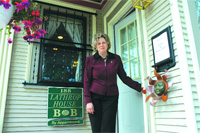


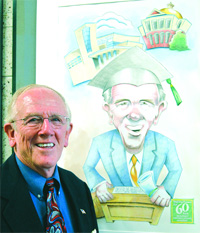

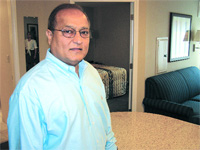






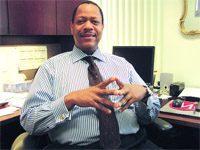


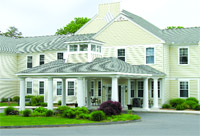
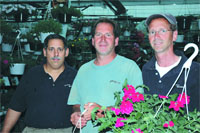

 There are two cases that stand out in Katherine Pacella Costello’s mind as defining moments in her career.
There are two cases that stand out in Katherine Pacella Costello’s mind as defining moments in her career.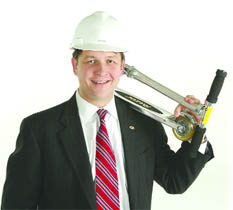 Richard Corder has spent the past few years leading two major construction projects: a $50 million expansion of Cooley Dickinson Hospital — and a tree fort he is building with his 10-year-old son, Harrison.
Richard Corder has spent the past few years leading two major construction projects: a $50 million expansion of Cooley Dickinson Hospital — and a tree fort he is building with his 10-year-old son, Harrison.




